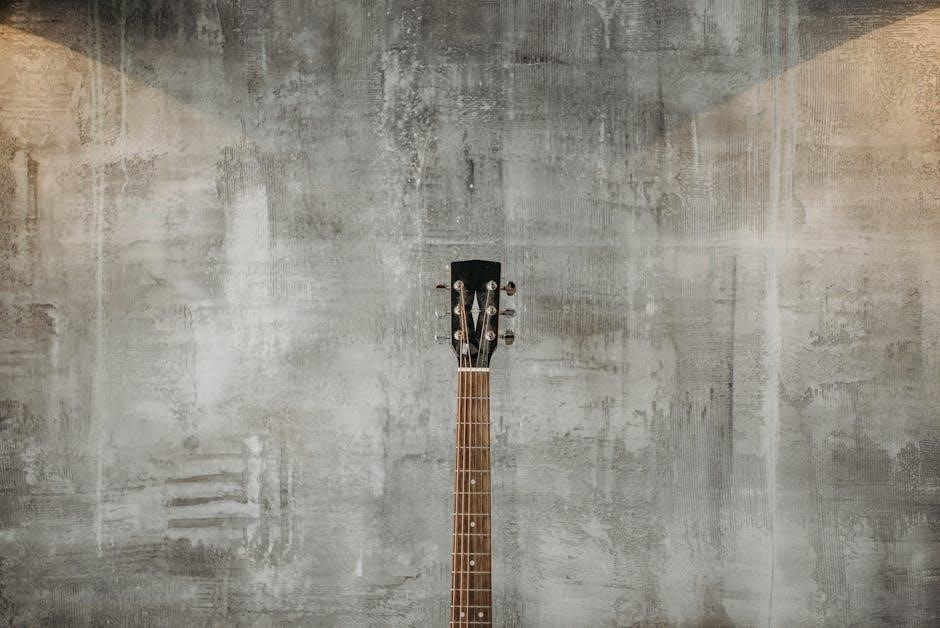The Circle of Fourths is a fundamental music theory concept organizing the 12 chromatic scale notes into perfect fourth intervals. It simplifies understanding key signatures, chord relationships, and scale structures, proving essential for guitarists to master the fretboard and enhance improvisation skills.
1.1 Definition and Basic Concept
The Circle of Fourths is a foundational music theory tool that organizes the 12 notes of the chromatic scale into a sequence of perfect fourth intervals. It begins with the note C and moves upward by perfect fourths (five semitones) through all keys, returning to C after 12 steps. This circular arrangement visually represents the relationships between keys, chords, and scales, making it easier to understand key signatures and harmonic progressions. For guitarists, it provides a framework to navigate the fretboard, identify chord shapes, and explore musical structures systematically. Mastery of this concept enhances improvisation, composition, and overall musicianship.
1.2 Importance in Music Theory and Guitar Playing
The Circle of Fourths is a cornerstone of music theory, simplifying key signatures, chord progressions, and scale relationships. It helps musicians understand how keys are interconnected, enabling seamless navigation of the fretboard. Guitarists benefit by identifying chord shapes, scales, and harmonic structures across all keys. This tool enhances improvisation, composition, and mastery of the fretboard. By visualizing the Circle of Fourths, guitarists can explore complex musical concepts with clarity, making it an indispensable resource for improving musicianship and versatility in various genres, from jazz to rock.

Understanding the Circle of Fourths
The Circle of Fourths arranges the 12 chromatic scale notes in a sequence of perfect fourths, creating a circular pattern. This structure helps musicians understand key relationships and harmonic movement.
2.1 The Chromatic Scale and Perfect Fourths
The chromatic scale consists of all 12 semitones within an octave. A perfect fourth spans five semitones, forming the basis of the Circle of Fourths. By arranging the chromatic scale in perfect fourths, the circle creates a harmonic framework, linking each key to its relative major and minor counterparts. This arrangement aids musicians in understanding key signatures, chord progressions, and scale relationships, making it indispensable for guitarists navigating the fretboard and composing music across various keys.
2.2 Relationship Between the Circle of Fourths and Circle of Fifths
The Circle of Fourths and the Circle of Fifths are closely related, as they both organize the 12 keys of the chromatic scale. The Circle of Fourths moves in intervals of a perfect fourth (five semitones), while the Circle of Fifths moves in perfect fifths (seven semitones). Notably, moving clockwise in the Circle of Fourths is equivalent to moving counterclockwise in the Circle of Fifths. This dual relationship simplifies understanding key signatures, as each key gains a sharp in the Circle of Fifths and loses a flat in the Circle of Fourths, providing a comprehensive harmonic framework for musicians.
2.3 Key Signatures and Their Order
The Circle of Fourths arranges key signatures in a sequence based on perfect fourth intervals. Starting from C Major, each subsequent key adds a flat or removes a sharp, following the order of the chromatic scale. The key signatures follow a specific pattern, with flats appearing in the order of B♭, E♭, A♭, D♭, G♭, C♭, and sharps appearing in the order of F♯, C♯, G♯, D♯, A♯, E♯. This system helps musicians understand the relationship between keys, enabling easier navigation of chord progressions and harmonization on the fretboard.

Practical Applications on the Guitar Fretboard
The Circle of Fourths simplifies navigating the guitar fretboard by visualizing key relationships and scale structures. It aids in identifying chord progressions, improvisation, and understanding key signatures through practical exercises.
3.1 Visualizing the Circle of Fourths on the Fretboard
Visualizing the Circle of Fourths on the guitar fretboard helps musicians understand the relationship between keys and scales. Unlike the linear piano keyboard, the fretboard’s layout requires recognizing repeating patterns. By mapping the Circle of Fourths, guitarists can identify key signatures, chord progressions, and scale structures more efficiently. This visualization technique simplifies navigating the fretboard, especially when moving between keys. Using diagrams or PDF guides, players can better grasp how perfect fourth intervals connect notes across the fretboard, enhancing their ability to improvise and compose music effectively. This practical approach makes the Circle of Fourths an invaluable tool for mastering the guitar fretboard.
3.2 Navigating Keys and Scales Using the Circle
The Circle of Fourths provides a structured way to navigate keys and scales on the guitar fretboard. By understanding the sequence of perfect fourths, musicians can easily identify key signatures and their corresponding scales. This system also highlights enharmonic equivalents, helping guitarists recognize scales that share the same notes but are spelled differently. The Circle of Fourths aligns with the guitar’s tuning, which is based on perfect fourths, allowing for efficient pattern recognition. This tool is particularly useful for improvisation and composition, as it enables seamless transitions between keys and scales, enhancing musical expression and technical mastery.
3.3 Improvisation and Composition Techniques
Mastery of the Circle of Fourths unlocks advanced improvisation and composition techniques on the guitar. Guitarists can use this system to explore chord progressions and melodic patterns seamlessly across the fretboard. By understanding the relationships between keys, musicians can create smooth transitions and modulations. The Circle of Fourths also aids in identifying common chord substitutions and extensions, adding depth to solos and compositions. Additionally, it enables the creation of complex, harmonically rich music by connecting scales and modes in a logical sequence, fostering creativity and technical precision in both improvisation and structured composition.

Chord Progressions and Harmony
The Circle of Fourths is a powerful tool for building chord progressions and understanding harmony. It helps guitarists identify common chord substitutions and extensions, enhancing harmonic depth in music.
4.1 Building Chords Using the Circle of Fourths
The Circle of Fourths is a valuable tool for constructing chords. By moving in perfect fourths, musicians can identify root notes for major, minor, and extended chords (e.g., 7ths, 9ths). This method simplifies finding chord substitutions and extensions, enhancing harmonic variety. Guitarists can use the fretboard layout to visualize these relationships, making chord building more intuitive. Understanding the Circle of Fourths also aids in recognizing common chord progressions and modulations, providing a deeper connection to music theory. This approach is especially useful for creating complex harmonies and exploring new sounds on the guitar.
4.2 Common Chord Progressions in Various Keys
The Circle of Fourths helps identify common chord progressions across keys. By moving in fourths, musicians can locate I-IV-V chords, minor and major variations, and substitutions. This pattern is ideal for creating smooth transitions and modulations. For instance, a progression in C Major (C-F-G) can shift to G Major (G-C-D) by moving one step in the Circle. This tool is particularly useful in jazz and rock for crafting intricate harmonic sequences. Guitarists can apply these progressions directly on the fretboard, enhancing their ability to compose and improvise in diverse musical contexts.
4.3 Modulation and Key Changes
The Circle of Fourths simplifies modulation by revealing key relationships through perfect fourth intervals. Moving clockwise or counterclockwise allows musicians to identify closely related keys for smooth transitions. Common techniques include using pivot chords or shared scales between keys. Guitarists can visually map these changes on the fretboard, enabling seamless key shifts. This method is particularly effective in jazz and progressive rock for crafting dynamic harmonic shifts. By understanding the Circle, players can master modulation, enhancing their ability to compose and perform complex, emotionally engaging music across various genres.

Scale Exercises and Melodic Patterns
Exploring the Circle of Fourths enhances scale mastery and melodic creativity. Guitarists can practice scales in fourths intervals, improving technique and harmonic understanding. This approach also aids in creating fluid, connected melodic lines across the fretboard, fostering musical expression and versatility in various genres.
5.1 Major and Minor Scales in the Circle of Fourths
The Circle of Fourths provides a structured approach to understanding major and minor scales. Each key within the circle corresponds to a specific major or minor scale, with accidentals added sequentially. Guitarists can use this framework to visualize and play scales across the fretboard, leveraging patterns like CAGED shapes. Practicing scales in the Circle of Fourths enhances familiarity with keys and improves improvisation. Additionally, this method helps in connecting scales through common tones, fostering fluid transitions and a deeper understanding of harmonic relationships. Regular exercises using the Circle of Fourths can significantly improve fretboard navigation and melodic phrasing.
5.2 Modes and Their Relationship to the Circle
Modes are closely tied to the Circle of Fourths, as each mode corresponds to a specific key within the circle. The Ionian mode (major scale) and Aeolian mode (natural minor scale) are central, while other modes like Dorian, Phrygian, Lydian, Mixolydian, and Locrian are derived from these. Guitarists can use the Circle of Fourths to visualize modal relationships, as each mode shares the same key signature but differs in tonal center. This relationship aids in creating modal interchange and enhances understanding of chord progressions. PDF guides often include exercises to explore these connections, helping players apply modes across the fretboard effectively.
5.3 Practical Exercises for Fretboard Mastery
Mastering the fretboard involves exercises that integrate the Circle of Fourths. Start with scales and arpeggios in all keys, focusing on perfect fourth intervals. Practice chromatic patterns and modal interchange to build familiarity. Use scale sequences and finger exercises to improve dexterity. Visualize the Circle of Fourths on the fretboard to enhance navigation. Download PDF guides for structured workouts, including fretboard diagrams and tablature. Regular practice of these exercises will deepen your understanding of the fretboard and improve your ability to play effortlessly across all keys. Consistency is key to unlocking advanced techniques and musical expression.

Resources and Tools
Explore free downloadable PDFs with tablature, online tutorials, and apps like Guitar Pro or Fender Play. These tools offer structured lessons, fretboard diagrams, and exercises to master the Circle of Fourths effectively.
6.1 Recommended PDF Guides for Guitarists
Discover essential PDF guides that simplify mastering the Circle of Fourths on the guitar fretboard. Titles like “Circle of Fourths Guitar Fretboard PDF” and “Scales & Circle of 4ths Modes” offer detailed diagrams, exercises, and tablature. These resources provide a comprehensive understanding of key signatures, chord progressions, and scale relationships. Many PDFs include structured lessons, fretboard visuals, and practical exercises to enhance musicianship. They are ideal for both beginners and advanced players, offering a clear pathway to mastering the Circle of Fourths and its application in various musical genres. Download these guides to deepen your understanding and improve your guitar skills effectively.
6.2 Online Tutorials and Lessons
Enhance your guitar skills with online tutorials dedicated to the Circle of Fourths. Websites like TrueFire and Guitar Tricks offer in-depth lessons on fretboard visualization, chord progressions, and scale navigation. Many tutorials include interactive tools, video demonstrations, and downloadable resources. Platforms such as YouTube feature channels like Guitar Lessons 365 and Andy Guitar, providing free step-by-step guides. These lessons cater to all skill levels, helping guitarists master the Circle of Fourths and its practical applications in various musical genres. Online forums and communities also share insights and exercises, making learning accessible and engaging for everyone.
6.3 Apps and Software for Learning
Discover a variety of apps and software designed to help guitarists master the Circle of Fourths. Tools like Fender Play and Guitar Pro offer interactive lessons and tablature to visualize scales and chords. Apps such as Fretboard Warrior and Yousician provide exercises and real-time feedback to improve fretboard navigation. Software like Transcribe! allows users to analyze and practice along with recordings. These resources make learning the Circle of Fourths engaging and accessible, helping guitarists of all levels deepen their understanding and application of music theory on the fretboard.

Advanced Techniques
Explore advanced techniques using the Circle of Fourths for complex compositions, jazz improvisation, and integrating music theory concepts. Master intricate chord progressions and scale modal interchange for sophisticated guitar playing.
7.1 Applying the Circle of Fourths in Jazz
In jazz, the Circle of Fourths is a powerful tool for creating sophisticated harmonies and melodies. By understanding the relationships between keys and scales, guitarists can navigate complex chord progressions seamlessly. This technique allows for modal interchange, enabling the use of multiple scales over a single chord progression, adding depth and variety to solos and compositions. Jazz musicians often practice scales and arpeggios in all twelve keys using the Circle of Fourths, fostering a disciplined approach to improvisation and enhancing overall musicianship. This method is particularly effective for crafting intricate, genre-defying music.
7.2 Using the Circle for Complex Compositions
The Circle of Fourths is invaluable for crafting intricate musical compositions. By arranging keys in perfect fourth intervals, composers can explore diverse harmonic possibilities, creating rich, layered soundscapes. This tool simplifies the process of modulating keys and experimenting with unconventional chord progressions. Guitarists can use the Circle to design complex arpeggios and melodies, ensuring a cohesive yet innovative structure. Additionally, it aids in visualizing relationships between scales and modes, making it easier to incorporate multiple musical styles into a single piece. This approach fosters creativity and precision, enabling artists to push boundaries in their work.
7.3 Integrating the Circle with Other Music Theory Concepts
The Circle of Fourths seamlessly integrates with other music theory concepts, enhancing harmonic understanding. It complements the Circle of Fifths, offering a dual perspective on key relationships. By linking keys through perfect fourths, musicians can better grasp chord functions, modal interchange, and scale compatibility. This integration simplifies analyzing complex compositions and improvising across multiple keys. Guitarists can apply this knowledge to create cohesive, dynamic pieces, bridging gaps between scales, arpeggios, and chord progressions. Mastery of this concept elevates compositional depth and musical versatility, making it a cornerstone of advanced guitar playing and music theory application.
The Circle of Fourths is a powerful tool for musicians, offering deep insights into harmony, scales, and chord progressions. Mastering it enhances guitar playing and compositional skills, fostering musical versatility and creativity.
8.1 Summary of Key Points
The Circle of Fourths is a foundational music theory concept that arranges the 12 notes of the chromatic scale in a sequence of perfect fourths. It is essential for understanding key signatures, chord progressions, and scale relationships. Guitarists benefit from its application on the fretboard, as it simplifies navigation and enhances improvisation. The circle is closely related to the Circle of Fifths, providing a complementary perspective on harmony. By mastering this concept, musicians gain a deeper understanding of western music structure, enabling more effective composition and performance. PDF guides and resources are invaluable for praktice and mastery.
8.2 Encouragement for Further Practice
Mastering the Circle of Fourths on the guitar fretboard is a rewarding journey that enhances musicianship and creativity. Consistent practice, even in short sessions, will deepen your understanding of key relationships and chord structures. Exploring PDF guides and online resources can provide structured exercises and inspiration. Embrace challenges as opportunities to grow, and remember that proficiency in this concept will unlock new possibilities for improvisation and composition. Stay motivated, and celebrate progress along the way—your dedication will lead to mastery and a richer musical expression.
